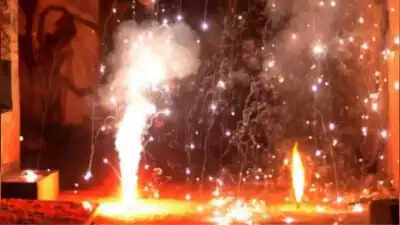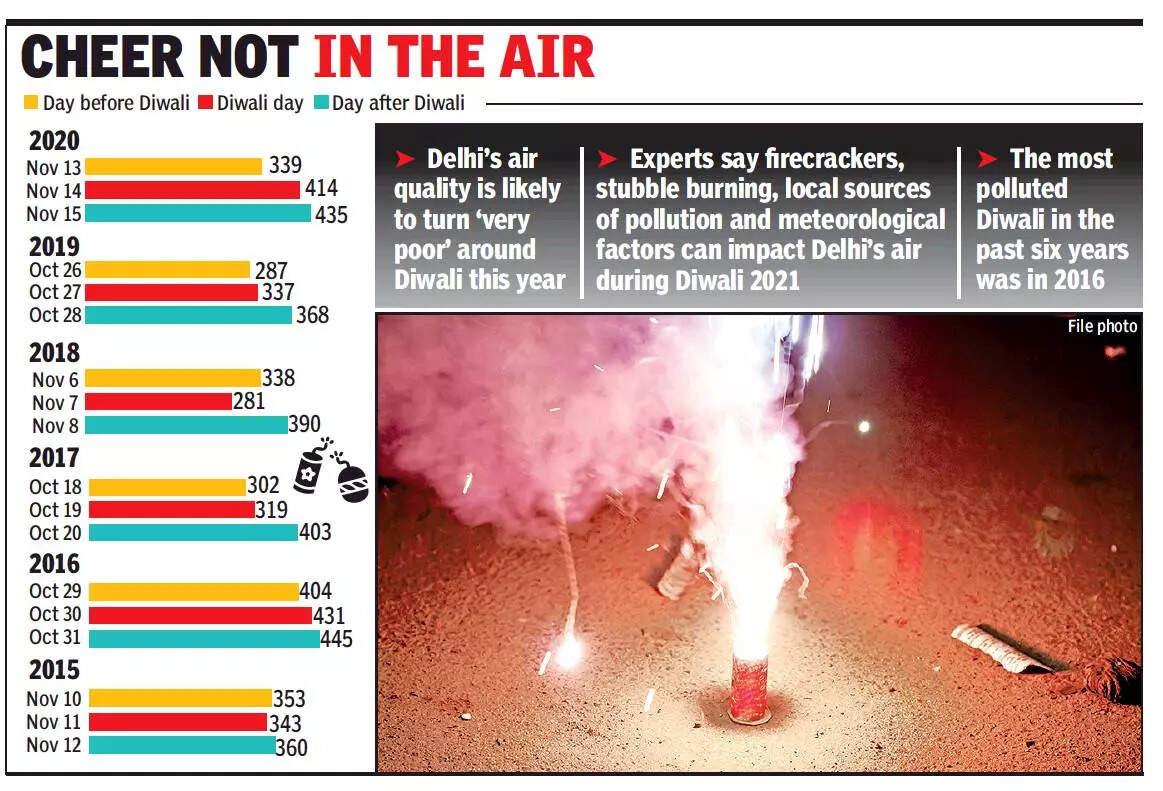Top Searches
- News
- City News
- delhi News
- Delhi may see its first 'very poor' day around Diwali
Delhi may see its first 'very poor' day around Diwali
Delhi may see its first 'very poor' day around Diwali

The city’s air quality, which has been hovering in the poor category for the past six days, is likely to turn very poor around Diwali, which will be celebrated on November 4. Experts said the air quality was likely to start deteriorating on the Diwali day due to stubble burning and winter inversion and, if banned firecrackers were burnt, it might get badly impacted.
NEW DELHI: The city’s air quality, which has been hovering in the poor category for the past six days, is likely to turn very poor around Diwali, which will be celebrated on November 4. Experts said the air quality was likely to start deteriorating on the Diwali day due to stubble burning and winter inversion and, if banned firecrackers were burnt, it might get badly impacted.
Data from Central Pollution Control Board (CPCB), which has been measuring the air quality index (AQI) since 2015, showed 2016 had the most polluted Diwali with a reading of 431 and 445 on the day after. Delhi’s 2020 Diwali was the worst since 2016 as the festival was observed in mid-November with unfavourable meteorological conditions. AQI, which was severe at 414 on Diwali, increased to 435 the next day.

In 2019, an AQI of 337 — very poor — was recorded on Diwali, which stayed in the same category at 368 the next day. A bigger spike was seen in 2018 when AQI rose from 281 — poor — on Diwali to 390 — very poor — the next day mainly due to firecrackers. Similarly, AQI deteriorated from very poor to severe in 2017, despite the festival falling in October.
Experts said Delhi had not recorded a very poor air day this winter, but the air quality might turn worse during Diwali. SAFAR’s founder project director, Gufran Beig, said, “The wind direction is likely to change from easterly to northwesterly on November 4, making it favourable for transportation of pollutants released by stubble burning in neighbouring states to Delhi. High local wind speed is currently allowing dispersion of pollutants, but calm wind conditions are expected from that evening.” The Diwali pollution blows up when the bursting of firecrackers, calm wind and colder nights are combined with stubble burning, he added.
Anumita Roychowdhury, executive director of research and advocacy at Centre for Science and Environment, said, “There is an additional concern this time that stubble burning may get concentrated within a shorter time frame and contribute to the first smog episode during Diwali.”
Dipankar Saha, former head at CPCB’s air laboratory, said AQI might reach around 350 on Diwali. “The other triggering factor is the atmospheric thermal boundary layer, which is generally low due to short day.”
Data from Central Pollution Control Board (CPCB), which has been measuring the air quality index (AQI) since 2015, showed 2016 had the most polluted Diwali with a reading of 431 and 445 on the day after. Delhi’s 2020 Diwali was the worst since 2016 as the festival was observed in mid-November with unfavourable meteorological conditions. AQI, which was severe at 414 on Diwali, increased to 435 the next day.

In 2019, an AQI of 337 — very poor — was recorded on Diwali, which stayed in the same category at 368 the next day. A bigger spike was seen in 2018 when AQI rose from 281 — poor — on Diwali to 390 — very poor — the next day mainly due to firecrackers. Similarly, AQI deteriorated from very poor to severe in 2017, despite the festival falling in October.
Experts said Delhi had not recorded a very poor air day this winter, but the air quality might turn worse during Diwali. SAFAR’s founder project director, Gufran Beig, said, “The wind direction is likely to change from easterly to northwesterly on November 4, making it favourable for transportation of pollutants released by stubble burning in neighbouring states to Delhi. High local wind speed is currently allowing dispersion of pollutants, but calm wind conditions are expected from that evening.” The Diwali pollution blows up when the bursting of firecrackers, calm wind and colder nights are combined with stubble burning, he added.
Anumita Roychowdhury, executive director of research and advocacy at Centre for Science and Environment, said, “There is an additional concern this time that stubble burning may get concentrated within a shorter time frame and contribute to the first smog episode during Diwali.”
Dipankar Saha, former head at CPCB’s air laboratory, said AQI might reach around 350 on Diwali. “The other triggering factor is the atmospheric thermal boundary layer, which is generally low due to short day.”
FacebookTwitterLinkedinEMail
Start a Conversation
end of article

